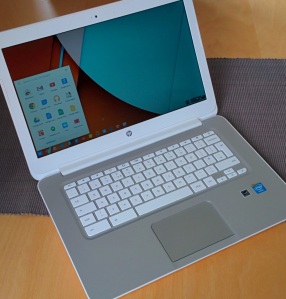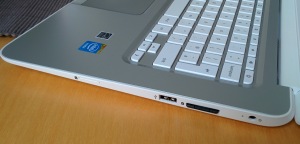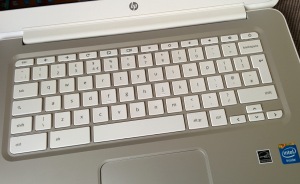There are two different aspects about this review. First, it’s not on a tech blog but a motorhome blog, and the second, this is not a new model but has just been discontinued at the time of writing.
To cover the first point, the tenuous connection with motorhoming is that I have purchased this laptop to use when travelling. For the last couple of years I have moved to using tablets when travelling, the excellent Nexus 7’s to be precise and an iPad for Anneli, but they are not great for large amounts of text input and I didn’t get on with using third party bluetooth keyboards. I do find the touch keyboard on the iPad is particularly good but is not always available when I’m in the mood to write. So, reading some tech stuff online about Chromebooks, curiosity got the better of me and I checked around to see what was available.
One element critics level at Chromebooks is that they are not proper laptops and need Internet connectivity to work, as the operating system is basically a Chrome web browser. After a little research, screen sizes on these basic laptops are generally around 11” inches but the reviews kept mentioning the Hewlett Packard Chromebook with a 14” screen. An 11” inch version is also available. All Chromebooks have WiFi connectivity so the Chrome browser can connect. This is great at home, school or the office networks but not always available on campsites or Aires but I spotted that HP made a version with a 14” inch screen and additional 3G connectivity via a SIM card slot.
So a quick visit to the Amazon store revealed an offering of different colours and specifications. I chose the Snow White version with 3G which duly arrived, except that it was not the 3G model delivered. A quick check back on the website and I had definitely ordered the right one so assumed that it was a picking error. The delightfully friendly customer services arranged an immediate replacement but this turned out to be incorrect too. Both were returned to Amazon and at this point I had lost a little interest in this project. Looking for alternatives I then found that the HP range was being refreshed for 2015 with a different processor and different memory options. I did find that the new Asus C300, available in bright red, had a Sim card slot in the press pictures but is not available in the UK. After a fair amount of Googling, I found out that HP UK was initially only offering the basic versions of the new model with no 3G option. Not giving up now, I started looking to find HP resellers that could possibly have some old stock then stumbled upon Laptops Direct who were offering a refurbished A1 graded 3G model in Snow White and for £40 less than the new price. It was worth the risk, it is in perfect, unmarked condition. Being picky, the accompanying quick start guide was for a Windows 8 laptop. I even managed to register the warranty on the HP website and claim two years free 100Gb Google Cloud storage. Result.
So what is the specification and what does it do?
Topline, the Chromebook runs on a 1.4GHz Intel Celeron low voltage Haswell processor with 4Gb of Ram on the 3G version and a 16Gb solid state hard drive, (SSD). Because, in theory, files are stored in the Cloud and programmes or Apps cannot be installed, storage space is not that crucial. The great advantage of a Chromebook is the instant start up, partly helped by the quick access SSD. It is literally ready to use when the lid is opened. The processor and matching graphics processor ensures that tasks and video run smoothly. There is a SD card reader and I am using a 32Gb card to store documents, photos, music etc for when connectivity is unavailable. Battery life is around 6 hours. Three USB ports are provided to add a mouse, keyboard, external drive, USB stick etc and an HDMI port to connect to a TV or monitor. There is a headphone out and mic in combined socket. Our of the box, new, this model has a Sim card provided with 250Mb a month data free for two years. Being a “seconds” or graded model, this was not included so a fresh GiffGaff Sim was installed, registered and working within ten minutes. 500Mb a month for £5. To complete the connectivity options there is Bluetooth connectivity and WiFi that can connect to the 5Ghz channel for improved video streaming and to overcome local interference on the more crowded 2Ghz band.
The anodised look silver keyboard with contrasting white keys works well for me and the standard layout for Chromebooks swaps some keys to take advantage of Google shortcuts. There is a large palm rest with a generous sized trackpad that works with multi gesture touch for scrolling and panning. Under the front side edges are stereo speakers with surprisingly good volume and clarity but with little or no bass response. Above the screen is an average quality webcam for video calling and taking snaps. A fairly sensitive microphone is fitted next to the camera and works well for dictation and Google search. The outer case has a rubbery textured, golf ball like finish to the base which has two ventilation grills in addition to the speakers and a smooth matt
white finish to the lid. After three days of use I noticed that there is a ventilation fan, it is that unobtrusive. A large chrome HP logo is in the centre of the lid with the trademark Chrome logo on the top left side.The laptop construction feels really sturdy and weighs about 1.9kgs.
All good so far then. The 14” inch screen is the weakest part of the package. It is low resolution with a gloss finish and although there is a brightness control, looks washed out most of the time. Viewing angles are narrow, but for my purposes, this is an advantage when used on trains and planes. Your neighbour is unlikely to be able to read the screen. I have not had the opportunity to use it outdoors in sunlight yet. For me though, this is an occasional travel companion with a decent keyboard and large screen. My iMac handles heavy tasks like, photo and video editing. Battery charging is via a bulky standard laptop mains cable and brick, a Micro USB connection would have been preferable.
Verdict – I really like the simplicity of a Chromebook. This HP series suits my requirements, at £210 offers good value, in the first couple of weeks ownership it has worked well using Wifi on a train and 3G connectivity is acceptable camping in Suffolk. The screen is poor compared to any of my other devices but I am really content with all other aspects of this Chromebook. Chrome is developing quickly, and appears to be working towards merging with the Android mobile OS. At the time of delivery a few Android apps were made available to use and most Chromebooks now support connecting Android phones by USB cable to transfer files and photos. A recommended solution for the mobile traveller looking for basic computing on the go.
Filed under: Reviews | Tagged: 1.4Ghz, 3g, Amazon, Android, Asus, Bluetooth, C300, camping car, Card, Celeron, Chrome, chromebook, Cloud, Direct, giffgaff, Google, Haswell, HDMI, hewlett, hp, Intel, internet, iPad, Laptops, Micro, motorhome, Nexus, packard, SD, sim, Snow White, SSD, USB, USB3, webcam, wifi, Windows | 1 Comment »







